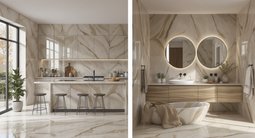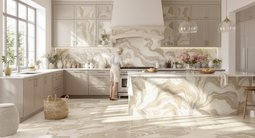TL;DR
Design is tilting toward authenticity in 2025, with vintage home decor and antique furniture anchoring modern rooms in history and tactility. The sweet spot is a thoughtful blend—old-soul details with clean-lined comforts—so your space feels collected, not cluttered. Try the 70/30 guideline for how to mix vintage and modern decor.
Introduction

Vintage materials and heirloom details warmly elevate a modern loft kitchen space.
Across living rooms, loft kitchens, and tiny studios, modern home decor is welcoming back the patina of age. Vintage home decor and antique furniture aren’t just aesthetic choices—they’re a response to sameness. People want rooms that feel lived in, crafted by hand, and full of stories. When a brass lamp shows its wear or a walnut sideboard bears a soft sheen, the space instantly gains depth. Here’s the thing: craftsmanship reads as comfort. Hand-turned legs, mortise-and-tenon joints, stained glass, and old oak floors have a weight you can feel underfoot. They mix beautifully with today’s smart technology and streamlined silhouettes. Done right, this blend offers the best of both worlds—heritage character with everyday ease. The result is a shift in mindset. Instead of buying a “look,” homeowners are curating a life. Designers often advise keeping scale generous, finishes honest, and the palette warm so vintage pieces can breathe and shine.
Trend Overview
This year’s interiors slow down—trading fast furniture for tactile longevity. You’ll see sustainability, warm neutrals, and sculptural lighting uniting the movement as people prioritize provenance and feel. Vintage home decor, architectural details, and reclaimed wood are recurring themes, alongside biophilic notes like linen, clay, and stone. The rule of thumb: let older pieces lead and modern layers support. Experts recommend starting with one statement antique, then building around it with quiet textures and clean lines so the room stays balanced and functional.
Anecdote
A young couple fell for a 1920s apartment because of a single arched doorway. They painted the walls a warm putty, swapped a bulky sectional for a clean-lined sofa, and centered an inherited walnut console under a modern sconce. The arch did the rest—one gesture made the whole place feel intentional. Another homeowner reupholstered a flea-market bergère in moss velvet; suddenly, the room looked curated instead of mismatched. And a seller restored stained glass sidelights before listing; the house went under contract in three days because buyers could see the story at the door.
Design Trend Sections
Patina Positive: Vintage Home Decor With Real Materials
Rooms feel instantly grounded when a timeworn table, copper pot, or plaster wall adds visible age. Designers often advise choosing one dominant vintage surface—wood, metal, or stone—to set the tone.
What’s driving it? Tactility and sustainability. Solid wood dressers, forged hardware, and wool rugs wear in, not out, creating the kind of everyday luxury you can touch. In practice, aim for a 70/30 mix of contemporary to vintage so the space reads collected, not costume. Keep 18 inches between sofa and coffee table for flow, and let vintage wood breathe with coasters and soft pads. Natural finishes like soap, wax, or oil protect patina without plastic shine. Experts note that a single heirloom anchor—think farmhouse table or antique console—can recalibrate an entire open-concept living room.
How to Bring It Home
- Choose one hero: a vintage dining table, credenza, or trunk; build modern seating and lighting around it.
- Favor honest finishes: oiled oak, unlacquered brass, and hand-thrown ceramics age gracefully.
- Keep sightlines clean—large pieces look best with negative space around them.
Architectural Charm: Arches, Stained Glass, and Exposed Brick
Authentic architectural details lend instant character, whether original or sensitively added. Designers advise keeping new interventions simple so old elements remain the star.
Buyers and renovators are embracing arches, millwork, and masonry because they add depth without clutter. A low-cost move: open a squared doorway into a shallow arch to soften a corridor. If you’re restoring stained glass, pair it with slim-profile windows for energy performance. For layouts, allow 36 inches of circulation around dining tables and islands to preserve historic bones while improving flow. Brick walls benefit from breathable limewash; it evens tone while letting texture show. A single original feature—an arched alcove, a paneled stair, or a reclaimed mantel—can define the narrative of a modern home.
How to Bring It Home
- Use limewash or mineral paint on brick and plaster to highlight texture without sealing it shut.
- Echo curves from arches in lighting or mirrors; repetition makes heritage feel intentional.
- Keep trim profiles consistent; one classic casing repeated beats a mix of styles.
Quiet Luxury Palette: Warm Neutrals, Aged Metals, and Layered Textiles
Warm neutrals and natural textures make antiques feel fresh, not fussy. Experts recommend a grounded palette—taupe, putty, mushroom, and olive—with one accent metal like aged brass or pewter.
The palette shift matters because it lets form and craftsmanship lead. Try a moss velvet on a vintage club chair or linen slipcovers on farmhouse dining seats; reupholstery modernizes shape without erasing history. For wall color, mid-tone neutrals (LRV 45–60) give contrast to dark woods while keeping light levels comfortable. Hang art at 57 inches on center for cohesion, and ensure table lamps fall between 24 and 30 inches tall for ambient balance. Layer three textures at minimum—wood, textile, stone—so even small spaces feel dimensional. The best way to incorporate antique furniture into a modern home is to quiet the backdrop and let the piece speak.
How to Bring It Home
- Mix one nubby textile (bouclé or wool) with one smooth (silk or sateen) per seating zone.
- Match metal temperatures: keep warm metals together and cool metals separate for clarity.
- Anchor with a vintage rug; allow 8–10 inches of floor around the perimeter in small rooms.
Trend Crossovers & Contrasts
Though each direction feels distinct, they share a return to texture, craft, and restraint. Warm neutrals link seamlessly with brick and walnut, while arches and vintage lighting ease the severity of straight-lined modernism. The big crossover is mindset: blend, don’t mimic. Keep modern comforts—open layouts, smart thermostats, induction—and let heritage show through materials and silhouette. A single antique table under a contemporary pendant or a curved doorway in a sleek kitchen is enough to shift the mood from showroom to lived-in.
Common Mistakes & Misconceptions
What People Often Get Wrong About 2025 Design Trends
- Treating “vintage” as clutter: edit ruthlessly. If it doesn’t serve function or story, let it go.
- Overmixing eras: pick a lead decade and one supporting influence to avoid visual noise.
- Painting over texture: limewash or oil, don’t seal brick and wood in glossy acrylic.
- Wrong scale furniture: bigger is calmer; aim for sofas 34–38 inches deep with ample clearance.
- Ignoring lighting layers: combine a vintage chandelier with modern dimmable lamps for balance.
Visualization Scenario
Picture a living room with limewashed plaster, an unlacquered brass floor lamp, and a vintage kilim underfoot. Use ReimagineHome to test warm taupe on the walls, drop in an antique trestle table, or preview an arched opening between kitchen and dining. Suggested alt text: “Warm neutral modern living room with antique furniture and arched doorway.” Suggested caption: “A quiet-luxury palette lets heirloom pieces lead.”
FAQ
FAQ
How should I mix vintage and modern decor without clashing?
Follow a 70/30 ratio of contemporary to vintage, keep sightlines clear, and repeat one shape or finish for cohesion. Neutral backdrops help antiques shine.
What’s the best way to incorporate antique furniture into a modern home?
Start with one anchor piece—like a dining table or sideboard—then add modern seating and lighting. Maintain 36 inches of circulation around major zones.
How do you style a vintage rug in a modern living room?
Use a solid or subtly textured sofa, echo one rug color in a pillow, and allow 8–10 inches of floor border. Keep coffee table legs slim to reveal pattern.
Where can I find authentic vintage pieces online safely?
Shop reputable marketplaces with seller ratings, ask for joinery and underside photos, and verify dimensions. Favor solid wood, wool, and brass over composites.
Conclusion
In 2025, the vintage revival isn’t about nostalgia for its own sake—it’s about emotion you can feel. Rooms that carry a nicked tabletop, a softened leather arm, or a wavy pane of glass invite you to slow down. They look better with time because they honor time. If you’re wondering where to start, pick one piece with history and let it lead the conversation. The rest—warm color, quiet lines, and considerate lighting—will follow. That’s how a modern home becomes a place with memory, presence, and ease.
.svg)

.svg)














.png)